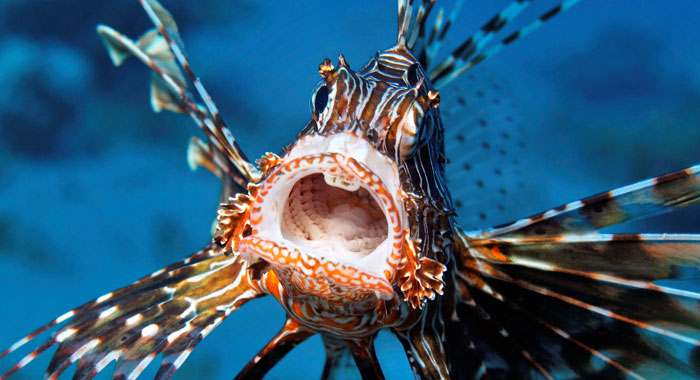The ocean is rich with biodiversity which supports a livelihood for fishermen. Ten percent of the world’s population depends on fisheries for livelihoods, and 4.3 billion people are reliant on fish for 15 percent of their animal protein. In the Caribbean, the ocean is under threat from pollution, overfishing, climate change, and the armour of the ocean which is the “Lionfish”.
The Lionfish can be deemed the armour of the ocean because it has eighteen venomous spines that are used defensively against predators, the only predators for the lion fish are” humans”. It is an invasive species which has the potential to wreak havoc in the ocean.
Scientists believe that the source of the invasion came from Lion fish being removed from home aquarium and disposed of in the Atlantic Ocean, which have caused it to invade and multiply rapidly in the Caribbean. According to a National Oceanic and Atmospheric article, the article states that lion fish has the potential to harm reef ecosystems because it is a top predator that competes for food and space with overfished native stocks such as snapper and grouper.
The article further went on to state that scientists fear that lion fish will also kill off helpful species such as algae eating parrot fish, allowing seaweeds to overtake reefs, and also a mature female releases roughly two million eggs a year. (https://oceanservice.noaa.gov/facts/lionfish-facts.html) .The Lionfish’s egg sac has a chemical deterrent that prevents other fish from eating it. The egg sacs are distributed via the water’s current. The eggs hatch in two days.
Lion fish can reach as far as 305 meters [10,000 feet] under water. They reach adult size when they are about two years old. Female lion fish starts to become sexually mature and lay eggs when they reach 7-8 inches in length or when they are about one year old. The parrot fish is very imperative for the formation of white sandy beaches. Research shows that parrotfish are responsible for about seventy percent of sand on tropical beaches.
The Parrot fish bite and scrape algae off of rocks and dead corals with their parrot like beaks, grind up the inedible calcium carbonate reef material [ made mostly of coral skeletons] in their guts, and excrete it as sand. They spend about 90 percent of their day eating algae off of corals and it is estimated that one parrot fish can produce 90kg of sand in a year (198 pounds) it is also estimated that one Hump head Parrot fish which is the largest species of the Parrot fish can produce 11,000 pounds of sand per year. This is a video from National Geographic showing how the parrot fish produces sand. (https://www.nationalgeographic.com.au/videos/great-blue-wild/the-most-talented-fish-in-the-sea-4321.aspx). This is why the Lion fish is a very dangerous fish because it can decline the parrot fish population and other fish which can cause a crisis in the ocean hence the reason in St.vincent and the Grenadines we need to demand more of the lion fish when we go at the fish market to purchase fish. This would encourage our fisher folks to go the extra mile to catch more of the Lion fish to reduce their population.
When we celebrate fisherman’s day in St.vincent and the Grenadines, we can also have a special award for persons who would have caught the most Lion fish and the private sector can get on board to help to reward prizes to our fisher folks. The Lion fish is venomous and not poisonous which makes it safe for consumption once the venomous spines are removed.
This video shows how to remove the venomous spines (https://www.youtube.com/watch?v=QDPDLyge98k).
The ball is in our court to reduce the lion fish population, let us start a campaign with the theme, “Lion fish we need more of you in our plate”.


